Written by Stephany Wilkes. Photographed by Paige Green.

In the six years since its inception, the Acadiana Fibershed has brought Acadian Brown cotton seedstock, cultivation, and culture back from the brink of near-permanent loss. In 2017, when only two known people had Acadian Brown Cotton (ABC) heirloom seed, the Fibershed affiliate set out to begin seed banking, revitalize Acadian cotton production with farmers committed to regenerative practices, and establish a short, fully traceable supply chain that honors and maintains Acadian culture. They have done that and then some.
Since we last profiled them in 2020, founder Sharon Donnan, Jennie Lallande, Larry and Andre Allain, and Randon and Jena Dufrene have re-established Acadian Brown cotton in diverse environments: a single-acre regenerative battleground bordering sugar cane fields, a suburban lot, and a small 12-acre farm. Together, they and other Acadiana Fibershed members are a living seed bank, ethnobotanists, craftspeople, educators, and land stewards.
Acadiana consists of twenty-two parishes in southern Louisiana. Tell people you’re going to Lafayette and they say, “Oh, you’re headed to Cajun country.” Billboards mark the way east from New Orleans and encourage drivers to “Stop here for live crawfish, boudin balls and cajun everything.” The roadkill is armadillos, a very large snake, and one alligator. Eventually, the highway becomes a bridge, the water of the Atchafalaya Basin spreads in every direction, and glorious old Cypress trees stretch up and out.
Jennie Lallande studied environmental science and farms full time in Iberia Parish, just south of Lafayette in New Iberia. She keeps livestock in the next parish over. Her one-acre lot holds a small brick house, a teenaged foster dog named Deuce, a Jesus mural chalked on the driveway by a Woofer (visiting organic farm worker), and a carport sheltering nursery trees waiting to be planted. An oil company donated the trees.

“I’m first and foremost a plant person,” Jennie says. “I want mixed species in every growing space. I say I have a demonstration farm, but I’m just demonstrating that you could actually have every plant you can imagine instead of a dead turf lawn.”
Those plants include Acadian Brown cotton. “Cotton does so well in very hot summers,” Jennie explains. “Here, most people stop gardening in June. You can grow okra and cotton and that’s about it. Cotton is a natural fit, rotating in as the summertime crop. My cooler weather plants and crops die off, and cotton takes their place. It gives us a lot of vegetation to keep those healthy systems cycling. I’m rotating mung beans, too.”
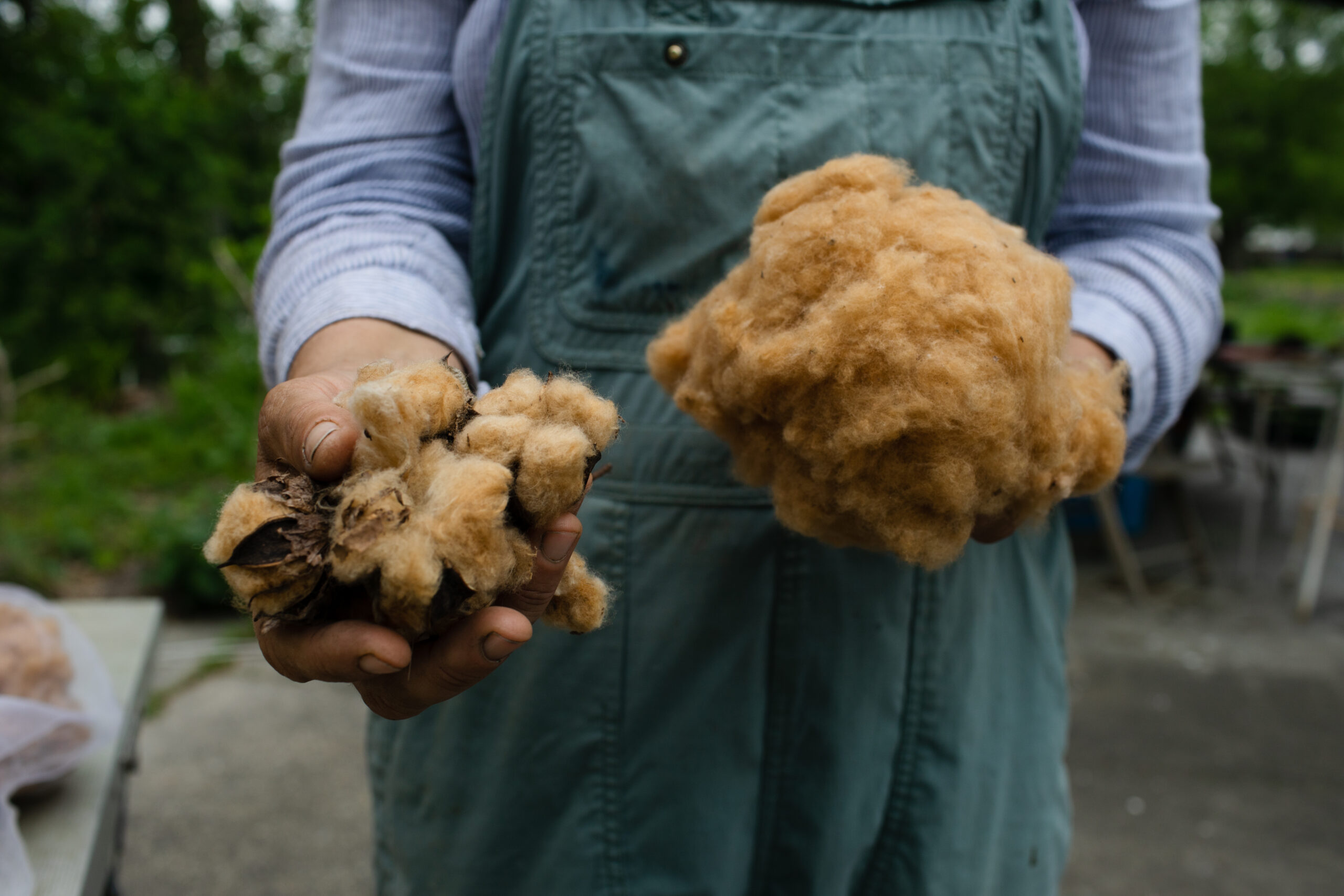
Fellow Acadiana Fibershed member Larry Allain agrees. “What Jenny said is absolutely correct,” he adds. “One of the gaps in our garden towns are crops that tolerate summer heat. Louisiana brown cotton fits that niche.”
Larry Allain and his son, Andre, are creating a 12-acre, regenerative oasis on an old race-horse farm, tucked away down a long driveway with a stand of pine trees serving as a friendly wall. Larry is an ethnobotanist, retired from a career as a prairie ecologist, “trying to grow and recreate what my Cajun ancestors grew,” he says. Andre lives in a tiny home he built himself and is enthusiastic about tropical plants, growing tea, and pigs and sheep.
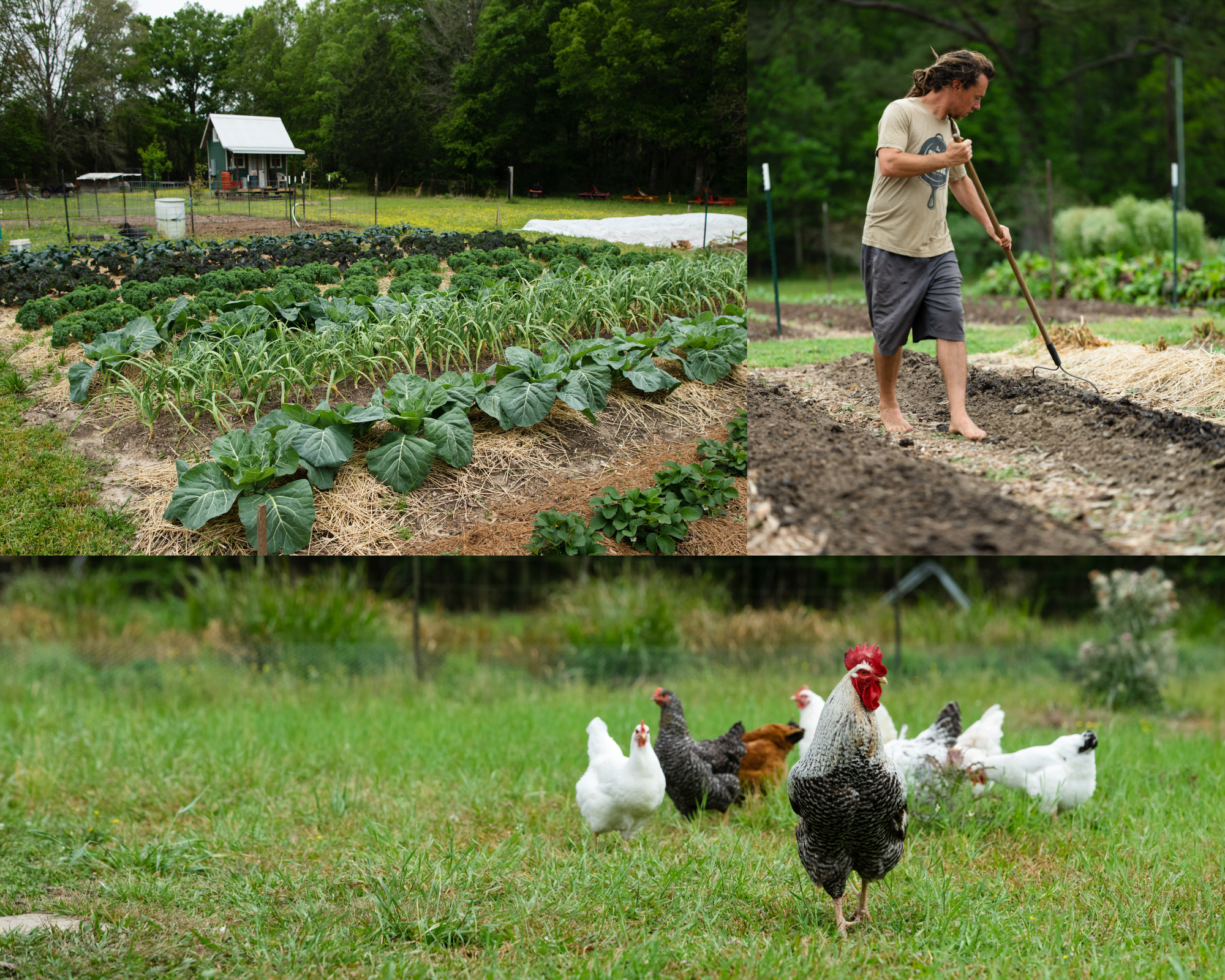
Their farm’s permaculture design incorporates forest and native grassland, in various successive stages. No chemicals are used but manure and compost are. Larry and Andre have rabbits for meat and manure; two pigs for natural tilling, compost and meat; and chickens for natural tilling. Once the farm is fenced, they want to add sheep “as a management tool for the native coastal prairie we are restoring on 7.5 acres,” Larry says. “Grazing is an essential component in these grassland ecosystems.”
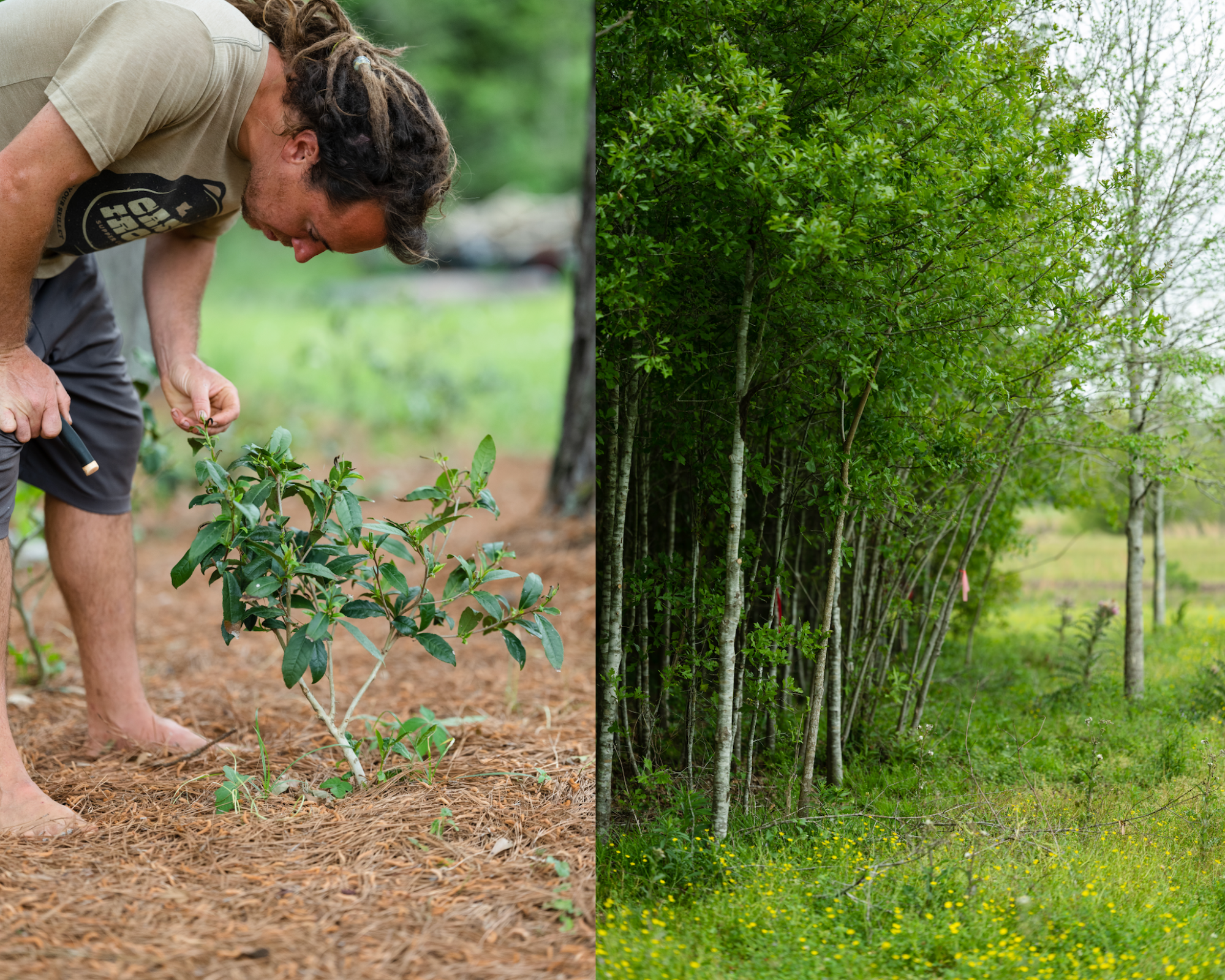
Randon and Jena Dufrene met while working as land managers. They work full time and live in Lafayette with their three kids, aged six, four and two. Randon and Jena tend an acre behind her parents’ house, west of Lafayette in a subdivision with big lots.
“We planted a small garden, mostly tomatoes and cucumbers with fruit trees,” Randon says. “We are growing cotton inside the vegetable garden which is always expanding. We have about 50 x 86 feet of growing space thus far, with plenty of room to fill in that back acre. We’re growing all sorts of vegetables, from tomatoes, cucumbers, corn, beans, garlic, onions, peppers, potatoes, strawberries, sorrel, gourd, and even cut flowers. We grow the cotton together with cover crops featuring Purple Hull peas, indigo, rye, clover, buckwheat and radish. All sorts of those fun things! As a family we love farming so much, trying new things each year, and finding seeds I can integrate with my cotton. It’s an absolute fun family crowd pleaser. I’m just trying to show my kids, you know, we can do this.”
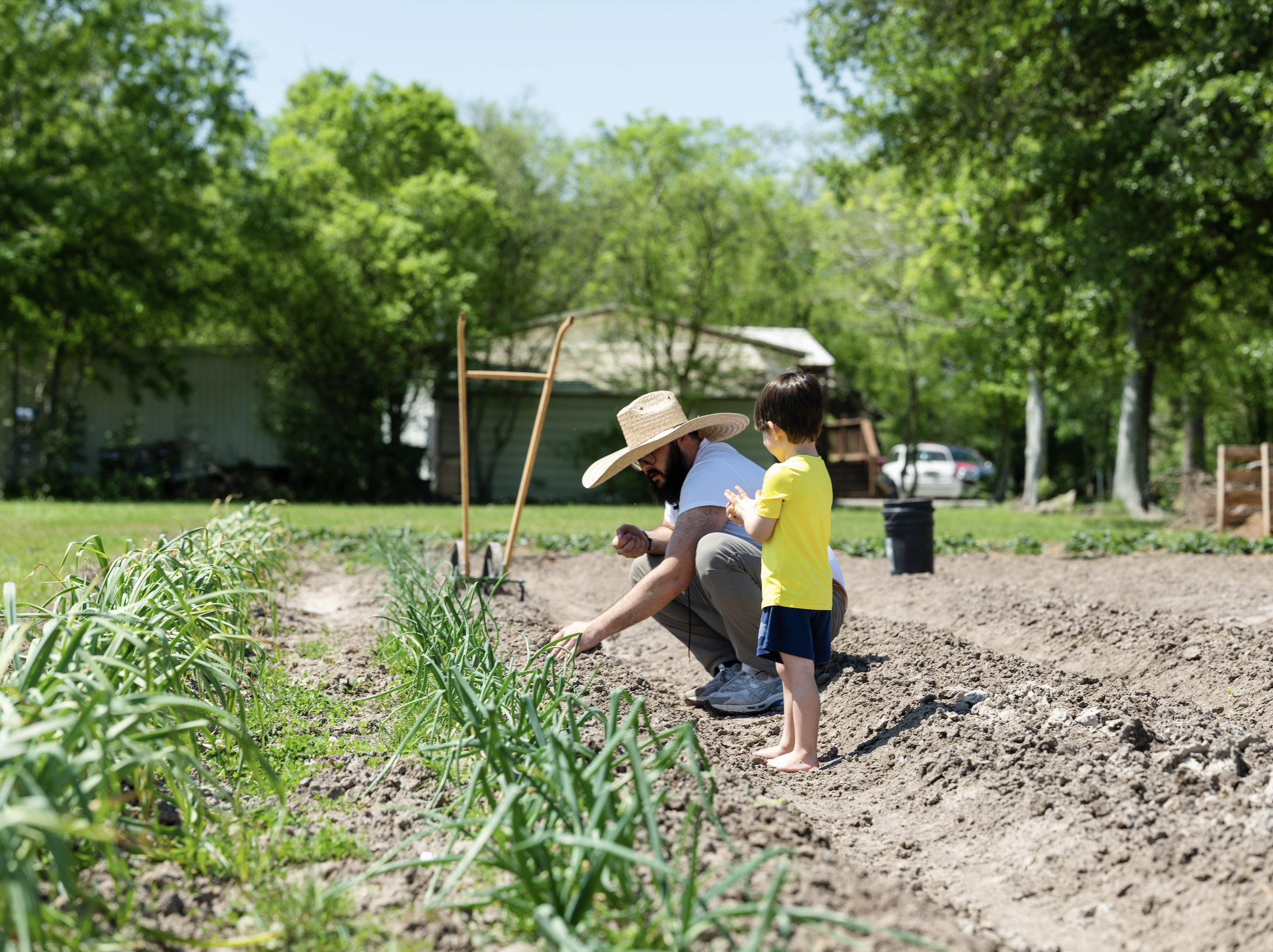
Why cotton? “It’s available,” Randon says. “You can grow cotton in your backyard and produce things with it. That was a big realization. My wife is a knitter and the traditional gift was cotton for the second anniversary, so I put two plants in the front yard, five years ago. And those two are now a field of cotton plants, because we need more cotton to hopefully produce more textiles. And in the process we’re learning about regenerative agriculture.”
Randon explains that in the past, where cotton now grows, his father-in-law grew cucumbers and tomatoes and used herbicides, pesticides and other commercial fertilizer products. He explained that this was simply the old way of backyard gardening in the area.
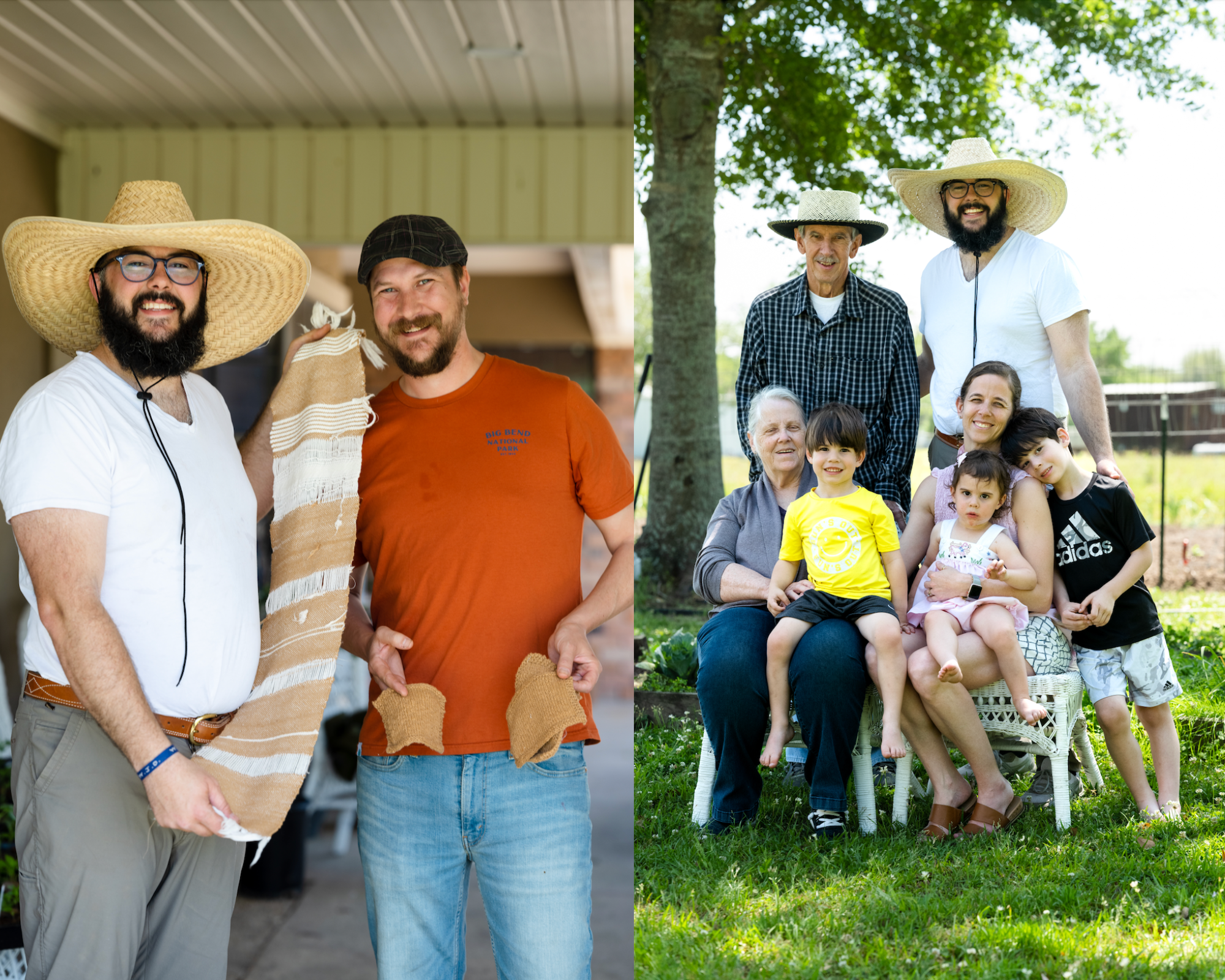
“So now we come in like, ‘I don’t want all that mess on my cotton,’” Randon laughs. “And so now you can’t have that on your tomatoes and your cucumbers, right? Let’s figure out a better way to do this. We were searching for answers. And we see the possibility with the Acadiana Fibershed to provide those not just for our family, but share that valuable information with others.”
Larry agrees. “Regenerative knowledge exists in a rare subset of people,” he says. “Farmers have to know how to rotationally graze, for example. It takes lots of knowledge and experience. You can’t learn from a brochure. It changes daily; you respond to rainfall and heat. But you begin to intuit. You can pick it up with principles. It’s no less important to learn about what aspects of regeneration work in your climate and your context, and for everything you’re trying to do. Because all that varies. So with cotton, it’s about how we grow it in a sustainable fashion. Cotton is a very heavy feeder, it uses a lot of nitrogen.”
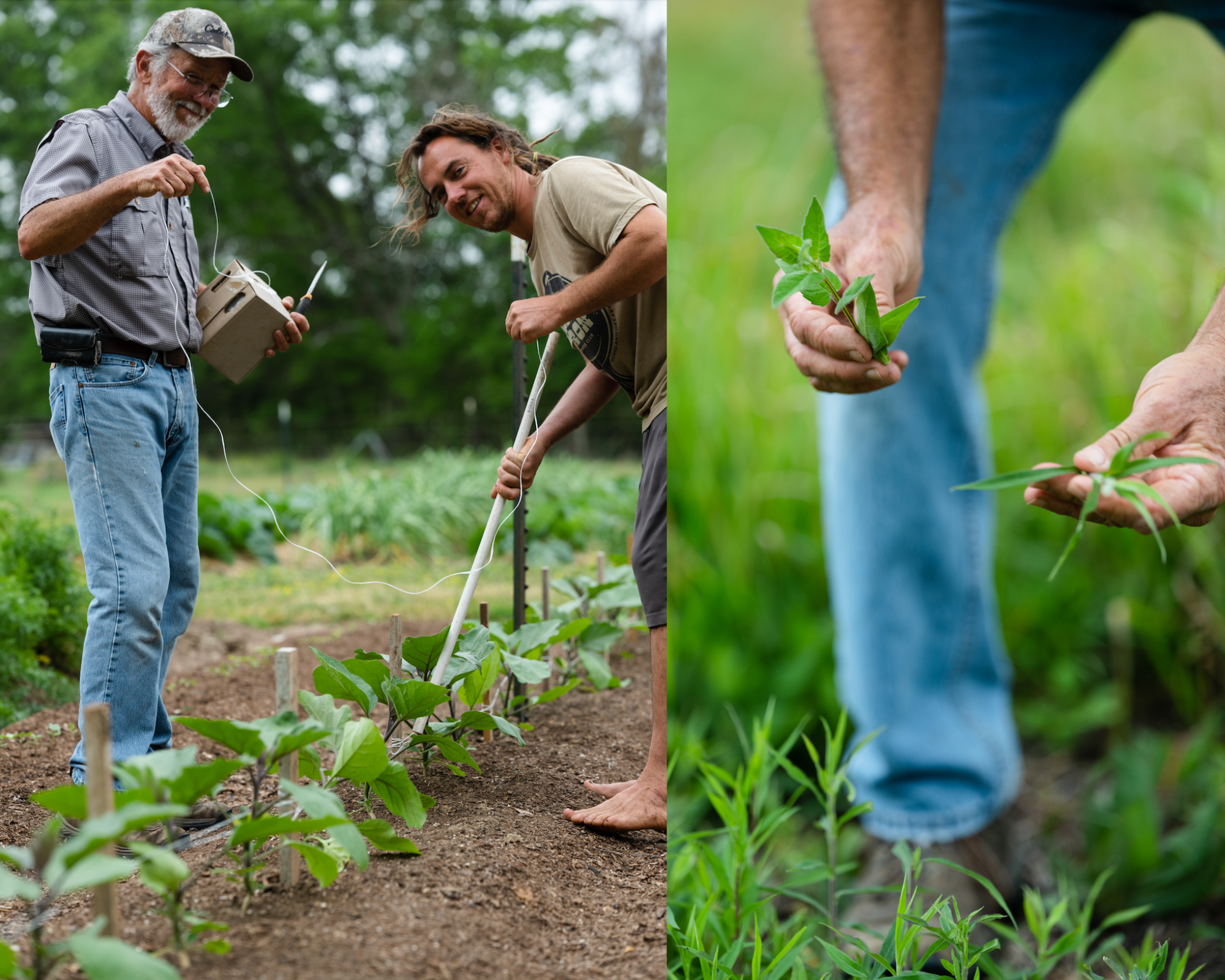
“And it’s tough,” Sharon adds. She describes cotton growing on river banks that had been seriously inundated and sharply eroded.
“That was Vermilionville,” she says. “I remember going out there, I don’t remember what year it was, in which hurricane or what it was, but the Vermillion flooded and the only thing that was left standing were our Acadian brown cotton plants. And they continued to bloom and yield cotton very well suited for our climate.”
Randon says, “That knowledge…Ms. Elaine, one of our seed-tradition bearers, she once told me, ‘Randon, in life you’ve got about 30 chances to grow cotton. You get 30 chances, 30 seasons to get it right.’ She put it in perspective. One season, like last year, we had tons of rain. If you left your cotton on the plant that year, the seeds were germinating in the fiber, which created a problem when it came to gin, because you had more trash inside the fiber. So you have to be on the lookout for the forecasts and things, because you have just 30 seasons. Can’t do it without knowledge.”
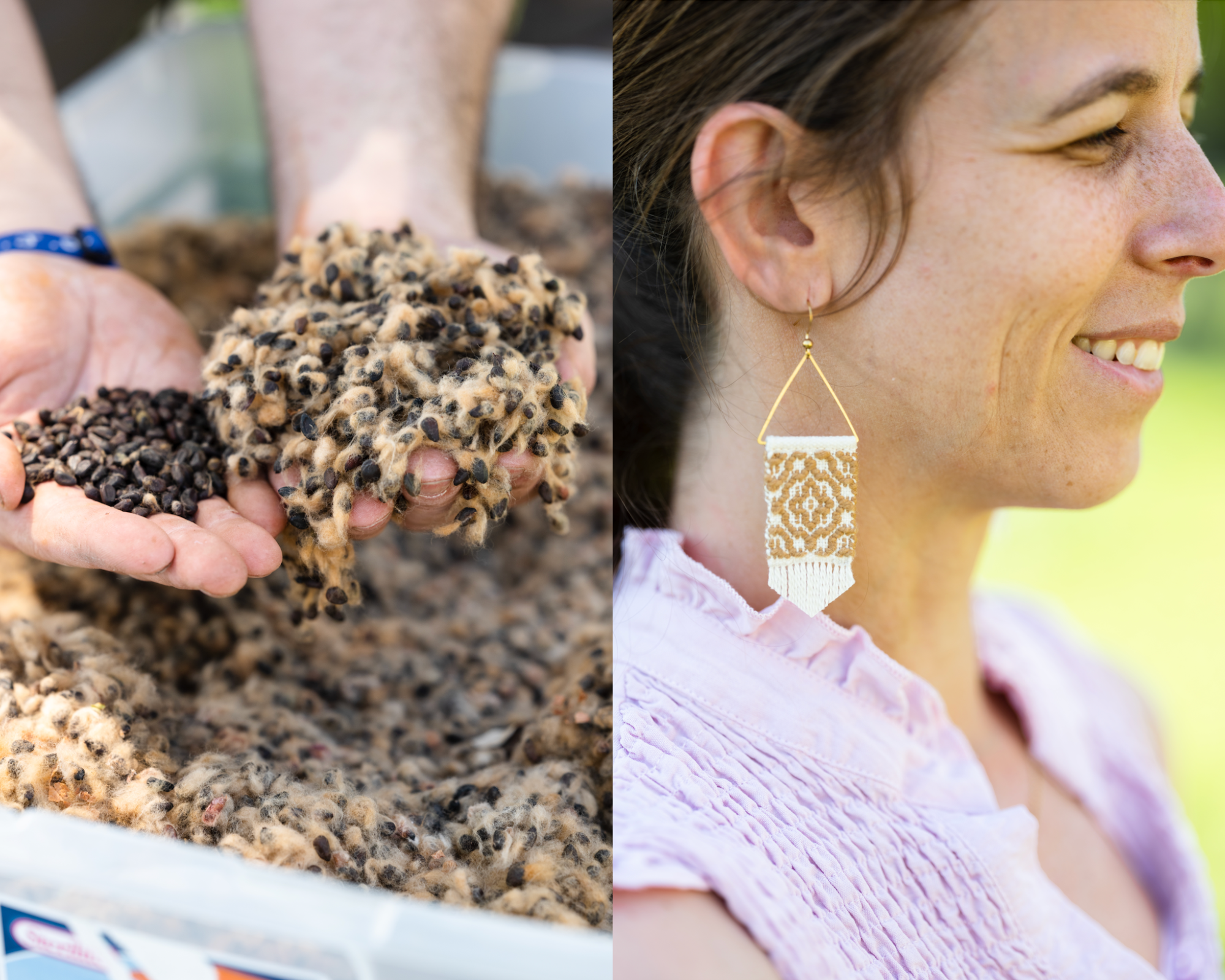
The Acadiana Fibershed has accomplished a great deal in a short time, including research and product development and agriculture policy changes.
Jennie has developed a fiber-yield-centric seed viability test. At the end of each growing season, all of the participating Acadian Brown cotton farmers turn in finished cotton bolls, she explains. “We take a weight on the unprocessed cotton bolls. Then we gin that and weigh both the seed and the fiber, to get a ratio of fiber to seed off of each person’s crop. Generally 25% of the total weight is fiber. So we do have a lot of seed that comes out of each crop. We had one farmer that turned in a crop with a 27% fiber-to-seed ratio.”

After the seed comes out of the cotton gin, members process it, then process it one more time to pick out the seeds with smooth seed coats, “the ones that don’t have a lot of fiber sticking to their seed coat,” Jennie says. “That’s the seed that we’ve been redistributing this year. It’s really about dollars and cents, because we pay the farmers for the raw, unprocessed cotton bolls. The more fiber that Acadian Brown cotton – as a fibershed – is able to get out of that crop, the less crop waste there is. We really are trying to dial in efficiency, to get more cotton fiber back for the same inputs and the labor cost.”
Randon recently got a batch of yarn back from a mill at Gaston College, “a beautiful yarn that we’re going to use to produce an article of clothing,” he says. “We’ll be purchasing the yarn that we produced in order to create fabric, so that we may put together an article of clothing to display as an example, because it can be done.”
Sharon points out that Larry and Andre are only growing Acadian Brown cotton today because of efforts the Acadiana Fibershed made to change the statewide policy of the Louisiana Boll Weevil Extermination Commission. (The boll weevil is a beetle whose larvae live entirely within the cotton boll, destroying both the seeds and cotton fibers.)
“In order to grow with us, to obtain our seed,” Sharon says, “you have to register with the Boll Weevil Commission. And up until a few years ago, that waiver included the right of the Department of Agriculture to come out and spray malathion (an insecticide) if they found boll weevils in your cotton. Well, our organic and regenerative farmers left us. That just simply was not going to happen. So we essentially lobbied the Department of Agriculture and Forestry and the head of that department agreed to no longer spray. We felt that was a huge victory for us. And Larry and Andre came back to us because the policy changed, and other young farmers are following suit.”
The Acadiana Fibershed has also established successful partnerships, including with the Material Institute in New Orleans, Gulf South for a Green New Deal (Gulf South 4 GND), and Sprout NOLA, an urban farming organization in New Orleans.
“Our next big push has to be the Farm Bill,” Sharon says. “Small farmers have had absolutely no representation, ever. It’s $480 billion that we’re talking about, and there isn’t a single person from Louisiana that’s on that Agricultural Committee. And Louisiana contributes a lot! I think that’s going to be one unifying part of this movement, to really try to grab our politicians from parish level all the way to national or federal, and really focus on small farmers and regenerative agriculture and how we can make a change in terms of climate. We’re all in it together. And there is power in that.”
“The network of Fibershed is you do what you can where you are, and realize you are not alone,” Randon says. “Other people are out there doing the work too. That is how we make change.”
Acadiana Brown Cotton is a part of Fibershed’s Producer Network — a membership-based network of farmers, ranchers, designers, sewers, weavers, knitters, felters, spinners, mill owners and natural dyers living and working within 51 counties in the North and Central regions of California. To connect with regional producers and their work, check out our Producer Directory.
Learn more about Acadiana Brown Cotton at their website: https://www.acadianbrowncotton.com/
Support and share Acadiana Brown Cotton on social media (Instagram and Facebook).
Interested in joining Fibershed’s producer community? Visit our Producer Program to learn more.
